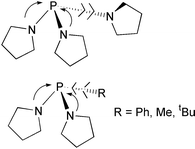Highly electron rich alkyl- and dialkyl-N-pyrrolidinyl phosphines: an evaluation of their electronic and structural properties
Abstract
Phosphines containing two N-bound pyrrolidine groups and one alkyl or aryl group have been prepared and shown to be unusually electron rich donor ligands when compared to either tris(N-pyrrolidinyl)phosphine or the trialkyl- or triaryl-phosphines. It is proposed that the electron donating ability of a pyrrolidine group towards phosphorus had been underestimated as only two pyrrolidinyl groups can donate towards the phosphine via the nitrogen lone pair. trans-L2Rh(CO)Cl complexes have been prepared from the phosphines and used to quantify the electron donor characteristics. Two of these complexes have been characterised by X-ray crystallography. The reaction of these phosphines with iron(II) complexes has also been studied. Platinum(II) complexes of the ligands have been prepared and also (in three examples) characterised by X-ray crystallography, which has enabled the steric and bonding properties to be evaluated. tert-Butyl(dipyrrolidinyl)phosphine is one of the most electron rich phosphines known. The dialkyl(pyrrolidinyl)phosphines have been found to contain less potent N→P donation, and are somewhat less good donor ligands.


 Please wait while we load your content...
Please wait while we load your content...